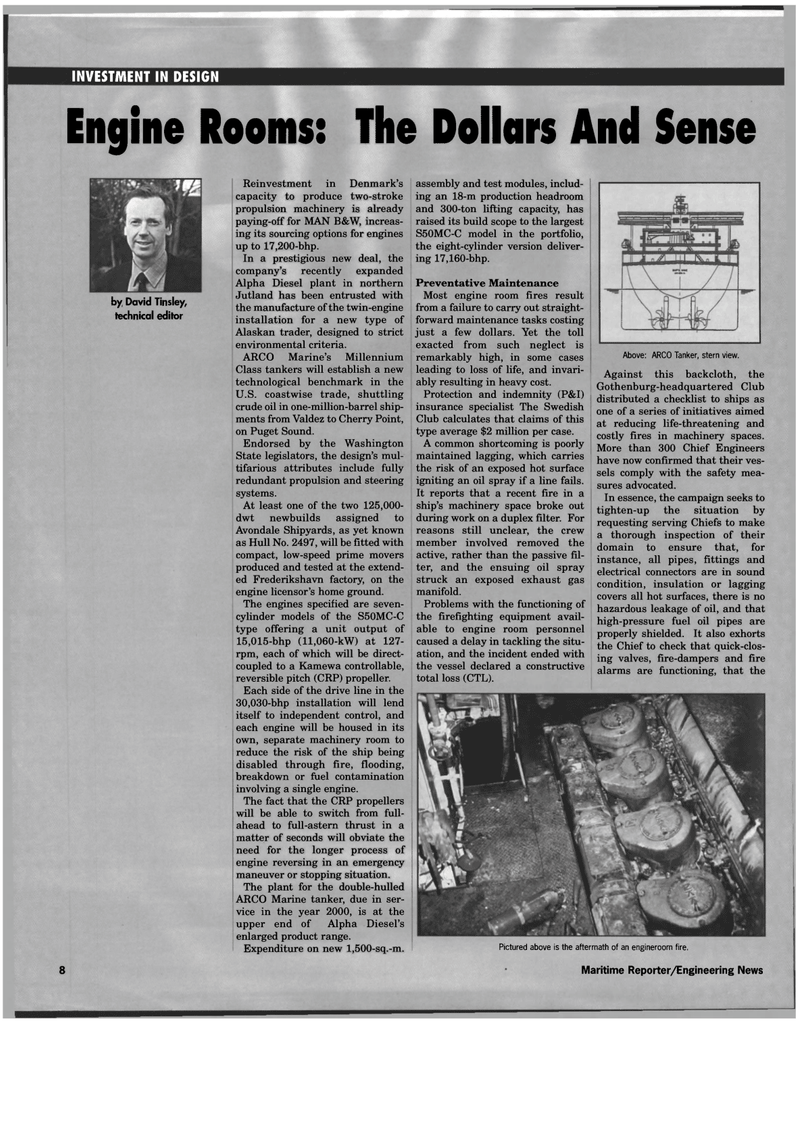
Page 8: of Maritime Reporter Magazine (February 1998)
Read this page in Pdf, Flash or Html5 edition of February 1998 Maritime Reporter Magazine
INVESTMENT IN DESIGN
Engine Rooms: The Dollars And Sense by David Tinsley, technical editor
Reinvestment in Denmark's capacity to produce two-stroke propulsion machinery is already paying-off for MAN B&W, increas- ing its sourcing options for engines up to 17,200-bhp.
In a prestigious new deal, the company's recently expanded
Alpha Diesel plant in northern
Jutland has been entrusted with the manufacture of the twin-engine installation for a new type of
Alaskan trader, designed to strict environmental criteria.
ARCO Marine's Millennium
Class tankers will establish a new technological benchmark in the
U.S. coastwise trade, shuttling crude oil in one-million-barrel ship- ments from Valdez to Cherry Point, on Puget Sound.
Endorsed by the Washington
State legislators, the design's mul- tifarious attributes include fully redundant propulsion and steering systems.
At least one of the two 125,000- dwt newbuilds assigned to
Avondale Shipyards, as yet known as Hull No. 2497, will be fitted with compact, low-speed prime movers produced and tested at the extend- ed Frederikshavn factory, on the engine licensor's home ground.
The engines specified are seven- cylinder models of the S50MC-C type offering a unit output of 15,015-bhp (11,060-kW) at 127- rpm, each of which will be direct- coupled to a Kamewa controllable, reversible pitch (CRP) propeller.
Each side of the drive line in the 30,030-bhp installation will lend itself to independent control, and each engine will be housed in its own, separate machinery room to reduce the risk of the ship being disabled through fire, flooding, breakdown or fuel contamination involving a single engine.
The fact that the CRP propellers will be able to switch from full- ahead to full-astern thrust in a matter of seconds will obviate the need for the longer process of engine reversing in an emergency maneuver or stopping situation.
The plant for the double-hulled
ARCO Marine tanker, due in ser- vice in the year 2000, is at the upper end of Alpha Diesel's enlarged product range.
Expenditure on new l,500-sq.-m. assembly and test modules, includ- ing an 18-m production headroom and 300-ton lifting capacity, has raised its build scope to the largest
S50MC-C model in the portfolio, the eight-cylinder version deliver- ing 17,160-bhp.
Preventative Maintenance
Most engine room fires result from a failure to carry out straight- forward maintenance tasks costing just a few dollars. Yet the toll exacted from such neglect is remarkably high, in some cases leading to loss of life, and invari- ably resulting in heavy cost.
Protection and indemnity (P&I) insurance specialist The Swedish
Club calculates that claims of this type average $2 million per case.
A common shortcoming is poorly maintained lagging, which carries the risk of an exposed hot surface igniting an oil spray if a line fails.
It reports that a recent fire in a ship's machinery space broke out during work on a duplex filter. For reasons still unclear, the crew member involved removed the active, rather than the passive fil- ter, and the ensuing oil spray struck an exposed exhaust gas manifold.
Problems with the functioning of the firefighting equipment avail- able to engine room personnel caused a delay in tackling the situ- ation, and the incident ended with the vessel declared a constructive total loss (CTL).
Above: ARCO Tanker, stern view.
Against this backcloth, the
Gothenburg-headquartered Club distributed a checklist to ships as one of a series of initiatives aimed at reducing life-threatening and costly fires in machinery spaces.
More than 300 Chief Engineers have now confirmed that their ves- sels comply with the safety mea- sures advocated.
In essence, the campaign seeks to tighten-up the situation by requesting serving Chiefs to make a thorough inspection of their domain to ensure that, for instance, all pipes, fittings and electrical connectors are in sound condition, insulation or lagging covers all hot surfaces, there is no hazardous leakage of oil, and that high-pressure fuel oil pipes are properly shielded. It also exhorts the Chief to check that quick-clos- ing valves, fire-dampers and fire alarms are functioning, that the
Pictured above is the aftermath of an engineroom fire. 8 Maritime Reporter/Engineering News

 7
7

 9
9
